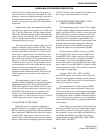
CIRCUIT DESCRIPTION
3-18
February 2001
Part No. 001-9800-001
Figure 3-6 Limiter/Detector U201 Block
Diagram
The 44.550 MHz injection frequency on pin 4 is
produced by tripling the 14.850 MHz frequency of
reference oscillator U806. To do this, a portion of the
reference oscillator signal is applied to Q207 which is
an amplifier with the output tuned for the third
harmonic of the reference oscillator frequency. This
output tuning is provided by a two-pole bandpass filter
formed by L219, C287, C288, L217, and C290. The
output level of this filter is approximately 0.25 V rms.
Ceramic Filters (Z202/Z206, Z205)
The 450 kHz output of the internal mixer is fed
out of U201 on pin 20. It is then routed through
ceramic filter Z202 for narrow-band (12.5 kHz) chan-
nels and through Z206 for wideband (25 kHz) chan-
nels. Z202 has a nominal bandwidth at the –3 dB
points of 8 kHz, and Z206 has a nominal bandwidth of
15 kHz. The function of this filter is to attenuate wide-
band noise present in the IF signal.
Routing of the IF signal to the appropriate filter is
provided by Q205 and Q206, PIN diodes CR207-
CR210, and several resistors and capacitors. It is
controlled by the microcontroller through the Q4
output of shift register U800. This output is low for
narrow-band channels and high for wideband
channels.
If a narrow-band channel is selected, a low signal
is applied to the base of Q205. That transistor then
turns off and inverter Q206 turns on. CR209/CR210
are then forward biased and CR207/CR208 reverse
biased. This routes the 450 kHz IF signal through
Z202 and blocks it from Z206. If a wideband channel
is selected, the opposite occurs. For more information
on the operation of PIN diodes, refer to Section 3.8.1.
The filtered 450 MHz IF signal is then applied to
pin 18, amplified by an internal amplifier, and then fed
back out on pin 16 and applied to ceramic filter Z205.
This filter is identical to Z206 and provides additional
attenuation of wideband noise. The loss introduced by
each ceramic filter is approximately 12 dB.
Limiter/Detector
The signal from Z205 is applied to an internal
limiter connected to pin 14. The limiter amplifies the
450 kHz signal and then limits it to a specific value to
remove amplitude variations. From the limiter, the
signal is fed internally to the quadrature detector. An
external phase shift network connected to pin 10 shifts
the phase of one of the detector input signals 90° at
450 kHz (the other input is unshifted in phase). When
modulation occurs, the frequency of the IF signal
changes at an audio rate as does the phase of the
shifted signal. The detector, which has no output with
a 90° phase shift, converts this phase shift into an
audio signal. Inductor L219 is tuned to provide
maximum undistorted output from the detector.
The audio signal is then fed internally to an audio
amplifier. The gain of this stage is set at about three by
R255 and R256. The audio output signal on pin 8 is
then fed to the audio/logic board.
Also in U201 is an RSSI detector which provides
a temperature compensated RSSI (Receive Signal
Strength Indicator) signal on pin 5. This is a low
impedance (2k ohm) output with a dynamic range of
70 dB. It provides an indication of IF signal strength
which changes in proportion to changes in signal
strength. It is routed to an A/D input of the microcon-
troller (pin 59) and used along with the squelch signal
to determine receive signal strength. R259/C304 and
R258/C303 provide low pass filtering, and C305 and
C306 decouple RF on the audio and RSSI output lines.
IF
Amp
RSSI
Mixer
Oscillator
20 19 18 17 16 15 14 13 12 11
Quad
Limiter
Vreg
+
-
-
+
Audio
10
9
8
7
65
43
2
1
E
B
Gnd
UHF RECEIVER DESCRIPTION


















